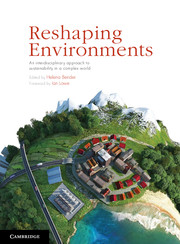Book contents
- Frontmatter
- Contents
- Contributors
- Acknowledgements
- Introduction Reshaping environments – an opportunity for envisioning the future
- Part 1 Cases
- 1 Costa Rica’s dry north-west
- 2 Reshaping land transport in Singapore
- 3 Evaluating different ways of managing forested landscapes
- 4 Changing the landscape management paradigm with farmers
- 5 Meeting development goals without blowing your carbon budget
- 6 The EGLE has landed
- 7 Reshaping the Murray-Darling Basin, Australia
- 8 Burning questions
- Part 2 Skills
- Part 3 Theory
- Index
- Plate Section
- References
6 - The EGLE has landed
architecture reshaping schools for environmentally sustainable and effective learning
from Part 1 - Cases
Published online by Cambridge University Press: 05 February 2013
- Frontmatter
- Contents
- Contributors
- Acknowledgements
- Introduction Reshaping environments – an opportunity for envisioning the future
- Part 1 Cases
- 1 Costa Rica’s dry north-west
- 2 Reshaping land transport in Singapore
- 3 Evaluating different ways of managing forested landscapes
- 4 Changing the landscape management paradigm with farmers
- 5 Meeting development goals without blowing your carbon budget
- 6 The EGLE has landed
- 7 Reshaping the Murray-Darling Basin, Australia
- 8 Burning questions
- Part 2 Skills
- Part 3 Theory
- Index
- Plate Section
- References
Summary
Introduction
Architecture is more than a way of producing an icon or a key idea that sells a building. It is about bringing together various design features and systems to provide an effective space for meeting its users’ needs. A sustainable school is one that adds energy to the electricity grid, collects more water than it needs, is an effective, healthy and engaging learning space for its teachers and students, and is a learning tool. An ‘Effective Green Learning Environment’ or EGLE is a classroom that supports teaching and learning through the provision of adequately lit, ventilated, thermally comfortable and acoustically effective spaces that are resource-efficient in construction and operation. EGLEs also provide opportunities for learning through interaction, understanding and engagement with the building, systems and space.
EGLE is an extension of the term ‘Effective Learning Environments’ (ELE), first coined by Fisher (2005). It adds the dimensions of environmental sustainability, the quality of the indoor environment, and the ability to use the building as a tool for learning. ELEs are expected to support teaching and learning by providing the appropriate facilities to carry out and support student-centred, problem-based learning through the use of multiple communication methods; engagement with knowledge in active, flexible ways; and the ability to work at different scales with different sized learning groups.
Information
- Type
- Chapter
- Information
- Reshaping EnvironmentsAn Interdisciplinary Approach to Sustainability in a Complex World, pp. 139 - 166Publisher: Cambridge University PressPrint publication year: 2012
